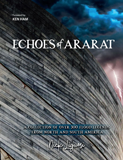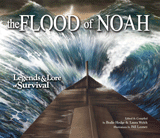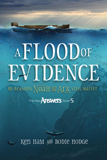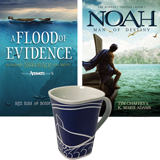
Flood Legends from the Americas, Part 1: Continental United States
Introduction
Do you know who the original inhabitants of the United States were? They are known as the First Nations peoples, and they include many tribes spread across this vast land—including the Cherokee, Navajo, Lakota, Delaware, Spokane, Apache, and so many more tribes.
Did you know that all of these tribes had historical traditions describing the great flood recorded in Genesis? Remarkably, traditions of this global flood have been among over 120 tribes from the continental United States—to say nothing of the rest of the world! Almost every tribe of which we have real historical data has a memory of the great flood.
Make no mistake: these traditions do not speak of a local flood or some generic flood story. They match the Noahic flood account on several specific details. There can be no doubt that they are referring to the flood of Noah, described in Genesis.
Amongst one hundred and twenty different tribes that I have visited in North and South and Central America, not a tribe exists that has not related to me distinct or vague traditions of such a calamity, in which one, or three, or eight persons were saved above the waters, on the top of a high mountain.
—George Catlin, early 19th-century explorer and painter
This expansive array of flood traditions, documented in my book Echoes of Ararat, is exactly what we would expect to find if the biblical account is true. This unequivocal body of evidence demands an explanation. It will be found that the only explanation that will do it justice is the truth of the Genesis record—in light of the sheer volume of these tribal traditions, their antiquity, and the specific details with which they match the Genesis account.
Southwest US Flood Legends
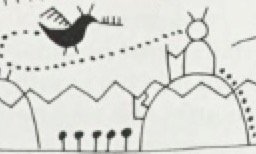
Portion of a replicated pictograph showing elements of the biblical flood of Noah
Beginning in Arizona, the Hualapai possess ancient rock carvings at Spirit Mountain, long predating the arrival of Europeans, which recount the flood and depict eight survivors. They narrate the history thus: “Rains fell on the earth for 45 days. The rising waters wiped out all peoples with the lone exception of an old man atop Spirit Mountain.” Then a bird was sent out, and on its second flight it returned “with grass in its beak to inform the man that the waters had receded.”1 This remarkably matches what Genesis says: “again he [Noah] sent the dove out from the ark. Then the dove came to him in the evening, and behold, a freshly plucked olive leaf was in her mouth; and Noah knew that the waters had receded from the earth.” (Genesis 8:10-11)
The Havasupai, another tribe inhabiting the Grand Canyon area, said that one girl survived the flood inside a hollow, floating tree, which is their version of the ark. “In this hollow tree he [God] placed food and other necessities, and also made a lookout window.”2
Flood Legends from the Americas
- Part 1: Continental United States
- Part 2: Canada and the Arctic
- Part 3: Mexico to South America
The Tohono O’odham of Arizona told that Montezuma (their Noah) was forewarned “that the flood was coming to destroy all living things upon the earth.” Heeding this warning, he “built a boat, in which he survived the deluge,” and “his boat, on the subsidence of the waters, rested on the topmost summit of Santa Rosa.” They replace Noah’s raven and dove with a coyote.3 The Pima said the flood was warned about in advance, that one man survived on a floating ball of resin, and that they know the mountain where it landed.4
“The earth was rent in great chasms,” said the Hopi, when God sent the flood in his wrath. They replace the ark with hollow floating reeds, and they have a memory of the birds sent to see if the flood was ending.5 The Navajo attribute the flood to man’s sinning and spoke of a “reed of great size” as the floating vessel. “When they were all safely inside, the opening closed, and none too soon, for scarcely had it closed when they heard the loud noise of the surging waters outside.” They also retain a vague memory of Noah’s raven and dove.6 The Acagchemem of southern California commemorated the flood in their songs and have a memory of God’s promise to Noah, never again to destroy the world with a flood.7

See the book Echoes of Ararat for more information on this subject.
The Cochiti, a pueblo people of New Mexico, told that a great boat was built and that “they began to load it with much corn and they took all the different animals into the boat with a white pigeon.” After the rains stopped, the chief said, “We will send the white pigeon to see if the earth is uncovered again.” The pigeon returned carrying a flower, taken as a sign that the flood was ending.8 “Once the whole world was flooded,” declared the Owens Valley Paiute. One man survived in a boat, in which he paddled around for a long time over the flooded earth.9
Kuterastan, the Noah of the Apache tribe, foresaw the flood and built a great vessel, which they called a “tus.” He sealed it with gum from the pinion tree, as with pitch. Those with him entered, and they sealed the vessel shut. “The flood completely submerged the earth for twelve days. Then the waters subsided, leaving the tus on the summit of the hill.” Two birds were sent out to survey the land when the flood ended. One account says seven people survived—one less than the biblical eight.10 We have found flood traditions from many other tribes of the southwest United States as well—some clearer and some vaguer. Yet even the vaguer ones show signs that they originated from the memory of Noah’s flood.
Then the dove came to him in the evening, and behold, a freshly plucked olive leaf was in her mouth; and Noah knew that the waters had receded from the earth. (Genesis 8:11)
Pacific Northwest US Flood Legends
What about the Pacific Northwest? Here, like everywhere else, we find ubiquitous testimony to the great flood. Myron Eells, in the 1870s, recorded the traditions of several tribes of this region. “When the earliest missionaries came among the Spokanes, Nez Perces, and Cayuses,” he said, “they found that those Indians had their tradition of a flood, and that one man and wife were saved on a raft. Each of those three tribes also, together with the Flathead tribes, has their separate Ararat in connection with this event.”11 They remember “the great canoe,” the mountain where it landed, and God sending the flood in judgment for man’s evil ways. The sending of the crow or pigeon is also recounted in some of these traditions.
When the earliest missionaries came among the Spokanes, Nez Perces, and Cayuses, who with the Yakimas live in the eastern part of the Territory, they found that those Indians had their tradition of a flood, in which one man and wife were saved on a raft. Each of those three tribes also, together with the Flathead tribes, has their separate Ararat in connection with this event.
—Myron Eells, ca. 1877
The Yakama spoke of a great flood that came, “one time in the early suns, back near the beginning.” Mankind provoked the Creator with their evil ways, but a good man received a word from God that a flood was coming. “I have heard from the Land Above, the land of the spirits, that a big water is coming—a water that will cover all the land. Make a boat for the good people. Let the bad people be killed by the water.” So they made a boat out of the largest cedar tree, and the good people were saved.12 In addition, we could cite the traditions of the Coos of coastal Oregon, the Makah, the Skokomish, and others, which confirm the Genesis record of the flood.
“Do you see that high mountain over there?” said an old Indian to a mountaineer, as they were riding across the Cascade Mountains, about seventeen years ago. “I do,” was the reply. “Do you see that grove to the right?” the Indian then said. “Yes,” said the white man. “Well,” said the Indian, “a long time ago there was a flood, and all the country was overflowed. There was an old man and his family on a boat or raft, and he floated about, and the wind blew him to that mountain, where he touched bottom. He stayed there some time, and then sent a crow to hunt for land, but it came back without finding any. After some time he sent the crow again, and this time it brought a leaf from that grove, and the old man was glad, for he knew that the water was going away.”
—Myron Eells, ca. 1878
Regarding the Tower of Babel, an old woman of the Swinomish Reservation narrated this tradition to Ella Clark: “Three sisters built a very high house, a long time ago. They made it tall because they wanted to go up to the sky to see the Creator. They kept building it higher and higher and higher. By the time the house was finished, they could not speak the same language. They could not understand each other. That is why there are so many different languages today.” The tradition also speaks of the flood.13 The Skagit of Washington State narrated, “When the people saw the flood coming, they made a great big canoe. They loaded it with two of everything living on earth, with the male and female of every animal and plant. When the flood was over, the canoe landed on the prairie in the Skagit country. Five people were in the canoe.”14
Great Plains and Northern Rockies Flood Legends
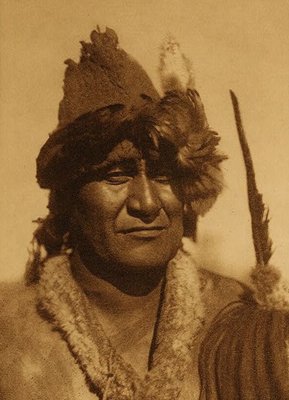
Packs-Wolf as Numak-Mahana, by Edward Curtis (1908)
In the 1830s, George Catlin stood in amazement as he was privileged to watch the annual ceremony of the Mandan tribe of North Dakota. This ceremony, which the Mandan have solemnly observed since ancient times, vividly preserved the memory of Nu-mohkmunk-a-nah, “the only man,” the Noah of the Mandan tribe. This man, they told, survived the flood and landed his big canoe on a mountain far to the west. This elaborate ritual demonstrated a memory of the flood very similar to the Genesis account even to several details. For example, Catlin described the “bull dance,” which was performed 40 times during this ceremony, “the exact number of days that it rained upon the earth, according to the Mosaic account.” The Mandans also highly esteemed the turtle dove, which they say returned to their Noah carrying a willow bough in its mouth as a sign of the retreating waters.15
The Pawnee of Nebraska remembered not only the flood and God’s anger at man’s sin that provoked it but also that “after the people were drowned, Tirawa [God] sent a little messenger, a bird, to visit the earth to see if the ground was all hard. Then Tirawa sent another bird, the crow, to visit the earth.” The crow only flew here and there, eating from floating corpses, but the bluebird returned to its master and since then has been honored on Pawnee ceremonial pipes.16
The Lakota said that the flood occurred because people did not know how to behave, and the Creator was not pleased. The Creator stomped on the earth, and “it split open in many places like a shattered gourd, and water flowed from the cracks until it covered everything.” That matches the language of Genesis 7:11—Noah’s description of the catastrophic plate tectonics that took place at the flood: “all the fountains of the great deep were broken up” (Genesis 7:11).17 The Lakota replace the ark with a giant sacred pipe and pipe bag, which contained “all manner of animals and birds.” They remember the crow that flew here and there. Then, the Lakota said, the Creator created mankind anew and told them, “Look: I have created a rainbow for you as a sign that there will be no more Great flood. Whenever you see a rainbow, you will know that it has stopped raining.”18 The Gros Ventres have a very similar tradition.
“The bad people were drowned and everything else that was not in the cane,” said the Wichita chief. They replace Noah’s ark with a giant cane, which the prophet had been instructed to prepare. Likewise, the voice from above told him to “select in pairs those animals he thought best should be saved,” among other parallels to Genesis.20 Likewise, the Blackfoot, Crow, Assiniboine, and other tribes have their flood traditions.21
That these people [the Mandan] should have a tradition of the flood is by no means surprising; as I have learned from every tribe I have visited, that they all have some high mountain in their vicinity, where they insist upon it the big canoe landed.
—George Catlin
The Arapaho tribe of Wyoming and Colorado shared their sacred tradition of the flood, which also mentioned the sending of a dove to search for land. “After a while, the dove returned and reported that the waters were over all things.” They also remember the construction of a boat or raft and the changing of languages that took place after the flood.22 The Utes told the early settlers how the ark landed on a mountain, which they claimed happened in the Rockies near what is now Denver.23 Another branch of the Utes say Pikes Peak was where the boat landed.24 The Eastern Shoshone remembered the sending of the two birds, but they replaced the dove with a chickadee.25 The Cheyenne held a Sun Dance ceremony, which bore witness to the deluge and contained a memory of God’s rainbow given to Noah as a promise.26 The Hidatsa remembered the flood and Noah’s bird in an annual ceremony, and there are other flood traditions from the Rocky Mountains besides these.27
Midwest US Flood Legends
Wesahkah built a great raft and escaped the Flood, with his family and all kinds of creatures. They later repopulated the world.
—Sauk and Fox tribes’ tradition of the Flood, according to Rev. Marsh
In 1766, the native peoples of Ohio told Charles Beatty, “once the water overflowed all the land, and drowned all the people then living, except a few, who made a great Canoe,” and that “a long time ago, the people went to build a high place to reach up a great way; and that, while they were building it, they lost their language, and could not understand one another.”28
The Sauk and Fox tribes of Wisconsin and Michigan spoke of their ancient patriarch Wesahkah, who is their Noah. This great man foresaw the coming flood, prayed to the Great Spirit, and obtained help. He built a great raft and survived with his family and all kinds of creatures.29 We also find memories of the great flood among the Menominee, Potawatomi, Winnebago, and others.30
Methodist minister J. Spencer said that the Shawnee tribe of Ohio and Kentucky related an account of creation and the pre-flood days that “agrees in all essential points with the Mosaic record.”31 The Iowa tribe told Reverend Hamilton their history about the flood that lasted twenty or thirty days and destroyed all mankind. The deity Ictinike drifted along in his canoe, and he sent two animals, including a bird which returned with “a branch on which are a few leaves.”32
On the other hand, many tribes of North America considered the Pipestone Quarry, in Minnesota, as their most sacred site. And several tribes claimed this as their Ararat.33
Northeast US Flood Legends
When we come to the northeastern United States, regretfully, we do not know as much about their beliefs and cultures due to the destruction of their way of life at an early date. Nevertheless, a tribe of the White Mountains area of New Hampshire told John Josselyn, in 1663, how a man and his wife in ancient times foresaw the coming flood. According to these natives, the pair fled to the White Mountains for refuge, taking only a rabbit. Later he set loose the rabbit, and when it no longer returned to him, he knew the flood had receded.34 This is clearly a memory of Noah’s dove. The Lenape or Delaware tribe of New Jersey and eastern Pennsylvania told David Zeisberger and the early Moravians how the whole earth had been submerged under water. They replace Noah’s ark with a giant floating turtle as the means by which two or three women survived. These sent a bird, which “flew far away, and returned with a small quantity of earth in his bill,” a memory of Noah’s dove.35
Not many generations ago, our people gathered at Mount Marcy to celebrate the 4,000th anniversary of the flood and to offer thanks to the Great Spirit for preserving life.
—Iroquois man in 1911
An old man of an Iroquois tribe, around the year 1911, related a tradition about the flood which destroyed all life—including the “huge, serpentine sea and land animals” (a reference to dinosaurs)—which used to inhabit the world. However, a few people foresaw the flood, being warned by the Great Spirit. These fled with their chosen animals to Mount Marcy, the highest peak of the Adirondack Mountains, which was the only place not submerged. These Indians remembered not only the fact of the flood but also the date! The old Iroquois man told how his people had commemorated the 4,000-year anniversary of their salvation from the flood, not many generations ago, giving thanks to the Great Spirit on the slopes of that great Adirondack mountain.36 This matches the biblical chronology very well—4,000 years from the biblical flood date of approximately 2348 BC places us at approximately AD 1653.
Southeast US Flood Legends
Our people have always had a tradition of the Deluge. . . . Great mountains of water came rolling in, which destroyed all the people, except a few families who had expected it and built a great raft, on which they were saved.
—Choctaw tradition of the flood told to George Catlin, ca. 1834
Moving toward the Southeast, we find the Cherokee, who told Henry Schoolcraft in 1846 that “the water once prevailed over the land, until every person was drowned but a single family.” The man had been forewarned that “he must make a boat, and put in it all he wished to save.”37 The Chitimacha of Louisiana replace Noah’s ark with a giant clay pot. They call the pigeon “ground-watcher” because it saw the ground come out when the flood subsided. They replace Noah’s raven with a woodpecker.38 The Natchez, Tunica, Atakapa, Yuchi, and other tribes of the Southeast likewise have their flood histories.
The Chickasaw say that the world was once destroyed by water. They made rafts to save themselves. . . . They say that one family was saved, and two of all kinds of animals.
—Henry Schoolcraft, ca. 1830
The Catawba, a tribe of modern-day North Carolina, say that the dove was sent and came back, first with a leaf and later with corn.39 “Seven or eight people had survived the Flood in a great canoe,” said the Powhatan people of Virginia to the early colonists in the 1600s.40 The Chickasaw hold that two of all kinds of animals were saved on a giant raft, along with one family.41 The Choctaw of Mississippi and Alabama have very well-preserved traditions of the flood and the Tower of Babel, differing mainly in that they say Babel occurred before the flood.42
The Caddo of Texas recalled how the violence of mankind “displeased Enicco, the Supreme Being, that he caused a great flood, which destroyed all but one family; consisting of four persons.” They told that “the only spot uncovered by the water” was a cave atop a very high hill, “where the male and female of all the kinds of animals were preserved,” and that “after the flood had continued one moon, they set a bird, called by them O-Wah, at liberty, which returned in a short time with a straw.” They have a memory of Noah’s ark as well, which they replace with a raft. The Caddo, together and many other tribes of the region, used to meet on a special day every year upon the hill where they believed their ancestors found refuge from the flood. Here they would offer sacrifices to God for not destroying all of mankind.43 The Alabama associated the flood with divine judgment, and other tribes, including the Coushatta, Tuskegee, and Apalachee, have flood histories with Genesis parallels. The Creeks spoke of two doves that returned with a blade of grass as a sign that the flood was subsiding.44
Conclusion
We have seen abundant and conclusive evidence from their historical traditions that the first tribes of the US knew of Noah’s flood. There can be no doubt that they are referring to Noah’s flood, described in Genesis.
Now we must make an accounting for all this evidence, for it has many implications for us. How are these traditions, with remarkable similarity to Genesis, to be accounted for? Is it merely by chance that they resemble Genesis? Are all these traditions and historical records inauthentic? Are “Christian missionaries” to blame for all this? Let our atheist friends make that argument, if they are prepared to do so. And we are just getting started! There is so much more wonderful evidence that we have yet to discuss, from the tribes and nations of the rest of the world, showing that they remembered the Noahic flood.
The truth is, the only explanation that will work is that the Genesis record of the flood is true. God’s flood happened, just as the Bible says. That has tremendous implications for us. And just as God lovingly rescued Noah and his family from the flood with the ark, Jesus lovingly gave up his life for us to provide perfect atonement and to rescue us from the judgment that our sin deserves.
In a future article we will explore the native traditions of the flood among the tribes of Canada and the Arctic.
Answers in Depth
2021 Volume 16
Answers in Depth explores the biblical worldview in addressing modern scientific research, history, current events, popular media, theology, and much more.
Browse VolumeFootnotes
- Leanne Hinton and Lucille J. Watahomigie, “Spirit Mountain: An Anthology of Yuman Story and Song,” Sun Tracks 10 (1984): 15–42.
- George Wharton James, The Indians of the Painted Desert Region (Boston: Little, Brown, and Co.: 1903), 209–211.
- M. O. Davidson, in “Arizona Superintendency,” Annual Report of the Office of Indian Affairs for the Year 1865 (Washington: GPO, 1865), 131.
- Hubert Howe Bancroft, The Native Races of the Pacific States of North America, vol. 3, (New York: D. Appleton and Co., 1875), 78–79.
- Frank Waters, Book of the Hopi (New York: Penguin Books, 1963), 18.
- Washington Matthews, Navaho Legends (Boston and New York: American Folklore Society, 1897), 64–65, 74–76.
- Geronimo Boscana, Chinigchinich, trans. Alfred Robinson (New York: Wiley and Putnam, 1846), 44–45.
- Ruth Benedict, “Tales of the Cochiti Indians,” Bureau of American Ethnology Bulletin 98 (1931): 2–3.
- Julian H. Steward, “Myths of the Owens Valley Paiute,” University of California Publications in American Archaeology and Ethnology 34, no. 5 (1936): 372, 363.
- Edward Sheriff Curtis, The North American Indian, vol. 1 (Cambridge, MA: University Press, 1907), 27–28; George Catlin, Last Rambles Amongst the Indians of the Rocky Mountains and the Andes (London: Sampson Low, Son, and Marston, 1868), 186.
- Rev. Myron Eells, “Traditions of the Deluge Among the Tribes of the North-West,” The American Antiquarian and Oriental Journal 1 (1878): 71.
- Lucullus V. McWhorter, “Yakima Tradition of the Flood,” McWhorter Manuscript Collection, Washington State University Library. Box 43, Folder 420, No. 16. As quoted in Ella Clark, Indian Legends of the Pacific Northwest(Berkeley: University of California Press, 1953), 45.
- Ella Elizabeth Clark, Indian Legends of the Pacific Northwest (Berkeley: University of California Press, 1953), 43.
- Clark, Indian Legends of the Pacific Northwest, 139.
- George Catlin, The North American Indians 1 (1926): 178–205.
- George A. Dorsey, The Pawnee, vol. 1 (Washington: Carnegie, 1906), 134–135, 296. George A. Dorsey, Traditions of the Skidi Pawnee (Boston: Houghton, Mifflin & Co., 1904), 23–24.
- For an excellent analysis of the geology of the flood, see Andrew Snelling’s work, Earth’s Catastrophic Past, or Timothy Clarey’s Carved in Stone.
- Richard Erdoes and Alfonzo Ortiz, American Indian Myths and Legends (New York: Pantheon Books, 1984), 496–498.
- Alfred L. Kroeber, “Gros Ventre Myths and Tales,” Anthropological Papers of the American Museum of Natural History 1 (1907): 59–61.
- George Amos Dorsey, The Mythology of the Wichita (Washington: Carnegie, 1904), 2.
- See my book, Echoes of Ararat, for more information.
- Sarah E. Olden, Shoshone Folk Tales, as Discovered from the Rev. John Roberts, a Hidden Hero, On the Wind River Indian Reservation in Wyoming (Milwaukee: Morehouse Publishing Co., 1923), 41. James A. Dorsey and Alfred L. Kroeber, Traditions of the Arapaho (Chicago: Field Columbian Museum, 1903), 15–16.
- Frank Hall, History of the State of Colorado, vol. 4 (Chicago: Blakely Printing Co., 1895), 93.
- Ernest Whitney, Legends of the Pikes Peak Region (Denver: Chain & Hardy Co., 1892), 25–29.
- Harry Hull St. Clair, ed. Robert H. Lowie, “Shoshone and Comanche Tales”, Journal of American Folk-lore, 22 (1909): 273.
- George A. Dorsey, The Cheyenne, Field Columbian Museum Publication 99, 9, no. 1 (1905): 144–145, 36–38.
- Prince Alexander Philipp Maximillian Wied, trans. H. Evans Lloyd, Travels in the Interior of North America (London: Ackermann and Co., 1843), 398.
- Charles Beatty, Journal of a Two Months Tour: With a View of Promoting Religion Among the Frontier Inhabitants of Pennsylvania and of Introducing Christianity Among the Indians to the Westward of the Alegh-Geny Mountains (London: William Davenhill, 1768), 90.
- Cutting Marsh, “Expedition to the Sacs and Foxes,” Collections of the State Historical Society of Wisconsin 15 (1900): 130–132.
- See my book, Echoes of Ararat, for more information.
- J. Spencer, “Shawnee Folk-lore,” Journal of American Folk-lore 22 (1909): 319.
- Rev. S. M. Irvin and Rev. William Hamilton, “Iowa and Sac Tribes,” in Information Respecting the History, Condition and Prospects of the Indian Tribes of the United States, ed. Henry Schoolcraft, part III (Philadelphia: Lippincott, Grambo & Co., 1853), 262–263. James Owen Dorsey, “Nanibozhu in Siouan Mythology,” Journal of American Folk-lore 5, no. 19 (1892), p. 300.
- See my book, Echoes of Ararat, for more information.
- John Josselyn, An Account of Two Voyages to New England Made During the Years 1638, 1663 (Boston: William Veazie, 1865), 105.
- Edmund de Schweinitz, The Life and Times of David Zeisberger (Philadelphia: J.B. Lippincott and Co., 1870), 218–219.
- Henry Wharton Shoemaker, “History of Tamarack Swamp: Another Page from Indian Antiquity,” Reading Times, January 6, 1912.
- Henry Schoolcraft, Notes on the Iroquois (Albany, NY: Erastus H. Pease & Co., 1847), 358–35
- John R. Swanton, “Indian Tribes of the Lower Mississippi Valley,” Bureau of American Ethnology Bulletin, No. 43 (Washington: GPO, 1911), 357-358.
- Frank G. Speck, “Catawba Texts”, Columbia University Contributions to Anthropology 24 (1934): 23.
- Stanley Pargellis, “An Account of the Indians of Virginia”, William and Mary Quarterly 16, no. 2 (1959): 235–236.
- Henry R. Schoolcraft, Historical and Statistical Information Respecting the History, Conditions and Prospects of the Indians Tribes of the United States, Part 1 (Philadelphia: Lippencott, Grambo & Co., 1851), 310.
- George Catlin, The North American Indians, vol. 2, 145; Horatio Bardwell Cushman, History of the Choctaw, Chickasaw and Natchez Indians (Greenville, TX: Headlight Printing, 1899), 283–284. David I. Bushnell Jr., “The Choctaw of Bayou Lacomb, St. Tammany Parish, Louisiana,” Bureau of American Ethnology Bulletin 48 (1909): 30.
- Thomas Freeman and Peter Custis, An Account of the Red River, in Louisiana, Drawn Up From the Returns of Messrs. Freeman and Custis to the War Office of the United States, Who Explored the Same, In the Year 1806 (Washington: YE Galleon Press, 1806), 28–29. Eds. Walter Lowrie and Matthew St. Clair Clarke, American State Papers, Class II: Indian Affairs, vol. 1 (Washington: Gales and Seaton, 1832), 729. For another Caddo version, see: George A. Dorsey, Traditions of the Caddo (Washington: Carnegie, 1905), 18–19. John Sibley, “Lewis and Clarke’s Expedition, Communicated to Congress, February 10, 1806,” American State Papers. Class 2, Indian Affairs (Washington: Gates and Seaton, 1832), 721.
- Henry Rowe Schoolcraft, Information Respecting the History Conditions and Prospects of the Indian Tribes of the United States, Part I (Philadelphia: Lippincott, Grambo & Co., 1853), 266.
Recommended Resources

Answers in Genesis is an apologetics ministry, dedicated to helping Christians defend their faith and proclaim the good news of Jesus Christ.
- Customer Service 800.778.3390
- © 2024 Answers in Genesis


